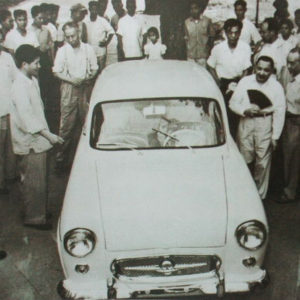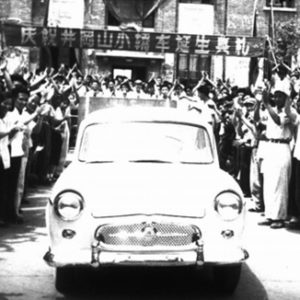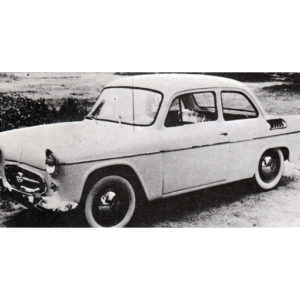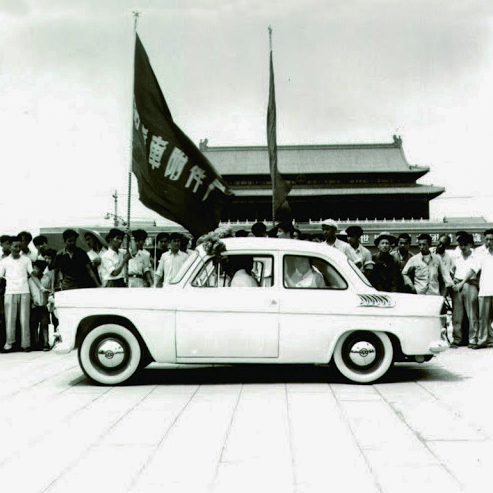In the past 30 years, and in particular the last ten, China’s car industry has grown exponentially. In the mid-1980s China built only a few thousand cars a year, mostly licensed designs or CKD kits, and private car ownership was extremely rare. Today there are 300 million vehicles on the road there, up from just 62 million in 2009.
But few people realize that Chinese cars actually go much further back than the reworked Citroëns and Daihatsus of the 1990s. These tiny archival photos are of the Jinggangshan, one of the very first Chinese domestic cars.

This little machine never really got beyond the prototype phase, but it was probably the first attempt at a car for actual people in China, rather than just a fancy limo for Party elites.
The long period of instability in China that began with the decline of the Qing regime in the late 19th century and ended with the Korean war ceasefire in 1953 effectively prevented car manufacturing from taking root in China.
During the period when other countries were starting to turn to mass production of automobiles, China entered the Warlord era, in which rival militias and military commanders effectively kept any kind of central government from functioning. After that came the Japanese invasion, World War II, and the the lengthy civil war between the Kuomintang and the Communists. It was only once the People’s Republic of China’s (PRC) first five-year plan went into effect that carmaking even became a possibility. Even then, the PRC remained a extremely difficult place to make cars.
In 1956, the same year the first Chinese-built trucks were made, plans began on several car projects that reached fruition about two years later.
The First Chinese Cars
The first domestically-produced car in China was the 1958 Dongfeng CA71, heavily based on the 1954 Simca Vedette with a Mercedes-derived engine shoehorned in. The second was the Hongqi CA72, based on a ’55 Chrysler but with its own styling. The latter quickly replaced the CA71, and both were built in Changchun, in Jilin province, by First Auto Works (FAW). The company still exists today.
The two FAW cars were intended as transport for the Party elite and were built in tiny numbers. Just 30 CA71s were built before the car was dropped in favor of the Hongqi limos that would become China’s most familiar diplomatic cars for the next 30 years.
Jinggangshan Takes Shape

The Jinggangshan was made in Beijing by the Beijing Auto Works (BAW). This facility was a former repair shop for military trucks, and the little car was far more ambitious than the FAW projects. It was a small car meant to be used as taxis or by local officials, who were a lot more numerous than party elites. A production run of 10,000 was planned. That was small potatoes by global standards even then, but wildly ambitious in a country that had only produced a few dozen cars at the time of the car’s June, 1958 launch.
Like the two FAW products, the Jinggangshan was based on a western car, the VW Beetle. The engineers (which included students and professors from local universities in Beijing) settled on the Volkswagen after deciding that Citroën’s 2CV was inadequate.
A sample VW was brought to Beijing, stripped down and reverse engineered. But BAW didn’t want to just copy the VW, so they designed their own shell. Two shells, in fact. The prototype two-door is seen in these photos, but production version was a four-door sedan.
The former looked vaguely like the later VW Type 3 Notchback, while the latter had many Hino Contessa vibes. Again though, these were a contemporary designs as both of the Type 3 and the Contessa were still three years in the future at the time.
30 Jinggangshans rode through Beijing in the 1st of October parade that year. They all ran through the parade but the engineering team still had many little problems to solve; the cars were mostly untested and overheating and overall durability were ongoing issues.
A Leap Too Far
While BAW worked on refining the car, forces were already in motion that scuttled the entire plan.
The cars were largely hand made and Beijing, while China’ political capital, was an industrial backwater. Automotive media often focuses on designers and factories, but the supply chain is also key to making cars happen, and it’s really hard to make a supply chain from scratch. Without the necessary suppliers and shops to build components reliably and in quantity, it’s impossible to make a mass-produced vehicle. While the design was basically sound, there was no way to scale up production to anything like 10,000 cars a year.

Very quickly the Great Leap Forward and the Sino-Soviet Split made things even worse. The former saw the very people who worked on the project, intellectuals and engineers, in the crosshairs of political partisans. The latter saw the withdrawl of important Russian industrial experts from many projects in China. Importantly, those first Chinese trucks were mostly of Russian design.
The challenge of making a new company and car from scratch, even one that’s based on an existing design, is a high hurdle to clear even when you don’t have those kinds of problems.
The Jinggangshan project stalled and ultimately ground to a halt. 154 sedans were made but all were eventually taken off the road due to a lack of spare parts. At the same time, the company was tasked with building two slightly larger cars derived from the Russian Volga M21, neither of which was built in great numbers.
Epilogue: Beijing Jeep
In 1961 BAW it began work on the BJ210/212, an off-roader with roots in the Russian GAZ-69. It became the China’s most produced vehicle until the 80s and is still in production today. In 1983, American Motors began a joint venture with BAW, Beijing Jeep, building XJ Cherokees. The vehicle proved extremely popular in China and indeed outlasted the American Cherokee by 13 years, only ceasing production in 2014. The company is still going today as part of the massive BAIC Group.
Note: The archival photos used in this piece were originally taken by the manufacturer.

